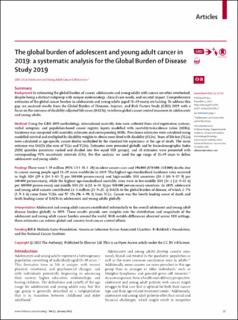The global burden of adolescent and young adult cancer in 2019: a systematic analysis for the Global Burden of Disease Study 2019
Alvarez, Elysia M; Force, Lisa M.; Kisa, Adnan; Murray, Christopher J L; Fitzmaurice, Christina; Kisa, Sezer; Bleyer, Archie; Bhakta, Nickhill; Adult Cancer Collaborators, GBD 2019 Adolescent Young
Peer reviewed, Journal article
Published version
Permanent lenke
https://hdl.handle.net/11250/2978423Utgivelsesdato
2021-12-29Metadata
Vis full innførselSamlinger
Sammendrag
Background: In estimating the global burden of cancer, adolescents and young adults with cancer are often overlooked, despite being a distinct subgroup with unique epidemiology, clinical care needs, and societal impact. Comprehensive estimates of the global cancer burden in adolescents and young adults (aged 15–39 years) are lacking. To address this gap, we analysed results from the Global Burden of Diseases, Injuries, and Risk Factors Study (GBD) 2019, with a focus on the outcome of disability-adjusted life-years (DALYs), to inform global cancer control measures in adolescents and young adults.
Methods: Using the GBD 2019 methodology, international mortality data were collected from vital registration systems, verbal autopsies, and population-based cancer registry inputs modelled with mortality-to-incidence ratios (MIRs). Incidence was computed with mortality estimates and corresponding MIRs. Prevalence estimates were calculated using modelled survival and multiplied by disability weights to obtain years lived with disability (YLDs). Years of life lost (YLLs) were calculated as age-specific cancer deaths multiplied by the standard life expectancy at the age of death. The main outcome was DALYs (the sum of YLLs and YLDs). Estimates were presented globally and by Socio-demographic Index (SDI) quintiles (countries ranked and divided into five equal SDI groups), and all estimates were presented with corresponding 95% uncertainty intervals (UIs). For this analysis, we used the age range of 15–39 years to define adolescents and young adults.
Findings: There were 1·19 million (95% UI 1·11–1·28) incident cancer cases and 396000 (370000–425 000) deaths due to cancer among people aged 15–39 years worldwide in 2019. The highest age-standardised incidence rates occurred in high SDI (59·6 [54·5–65·7] per 100 000 person-years) and high-middle SDI countries (53·2 [48·8–57·9] per 100000 person-years), while the highest age-standardised mortality rates were in low-middle SDI (14·2 [12·9–15·6] per 100000 person-years) and middle SDI (13·6 [12·6–14·8] per 100000 person-years) countries. In 2019, adolescent and young adult cancers contributed 23·5 million (21·9–25·2) DALYs to the global burden of disease, of which 2·7% (1·9–3·6) came from YLDs and 97·3% (96·4–98·1) from YLLs. Cancer was the fourth leading cause of death and tenth leading cause of DALYs in adolescents and young adults globally.
Interpretation: Adolescent and young adult cancers contributed substantially to the overall adolescent and young adult disease burden globally in 2019. These results provide new insights into the distribution and magnitude of the adolescent and young adult cancer burden around the world. With notable differences observed across SDI settings, these estimates can inform global and country-level cancer control efforts.
Utgiver
ElsevierSerie
The Lancet Oncology;Volume 23, Issue 1Tidsskrift
The Lancet OncologyOpphavsrett
© 2021 The Author(s)Beslektede innførsler
Viser innførsler beslektet ved tittel, forfatter og emneord.
-
“A limited focus on cancer rehabilitation”—A qualitative study of the experiences from Norwegian Cancer Coordinators in Primary Health Care
Lie, Nataskja-Elena Kersting; Koren Solvang, Per; Hauken, May (European Journal of Cancer Care; Volume 28, Issue 4. Special Issue: Themed section on Re‐imagining Psycho‐Oncology. July 2019 e13030., Journal article; Peer reviewed, 2019-01-17)Objective: The facilitation of complex cancer rehabilitation interventions in primary health care has become of growing importance to meet the bio-psycho-social needs of cancer survivors. However, the delivery of cancer ... -
Somatic EP300-G211S mutations are associated with overall somatic mutational patterns and breast cancer specific survival in triple-negative breast cancer
Bemanian, Vahid; Noone, John Cristopher; Sauer, Torill; Touma, Joel Joul; Vetvik, Katja K.; Söderberg-Naucler, Cecilia; Lindstrøm, Jonas Christoffer; Bukholm, Ida Rashida Khan; Kristensen, Vessela N.; Geisler, Jürgen (Breast cancer research and treatment;172(2), Journal article; Peer reviewed, 2018-08-21)Purpose We have compared the mutational profiles of human breast cancer tumor samples belonging to all major subgroups with special emphasis on triple-negative breast cancer (TNBC). Our major goal was to identify specific ... -
The role of cancer coordinators in improving collaboration in cancer care at local levels following the coordination reform
Moshina, Nataliia (Master thesis, 2014)The present study is devoted to one area of change in the Norwegian cancer care associated with the Coordination Reform implemented in 2012. More specifically, my aim has been to shed light on the role cancer coordinators ...

